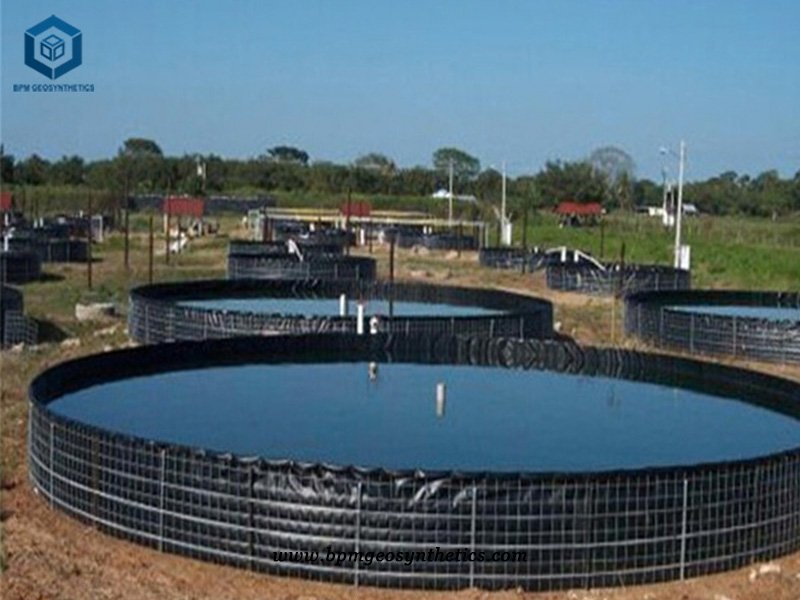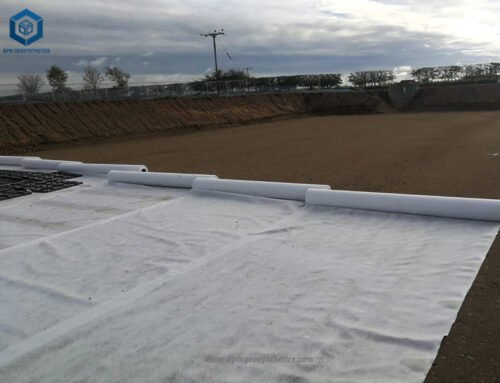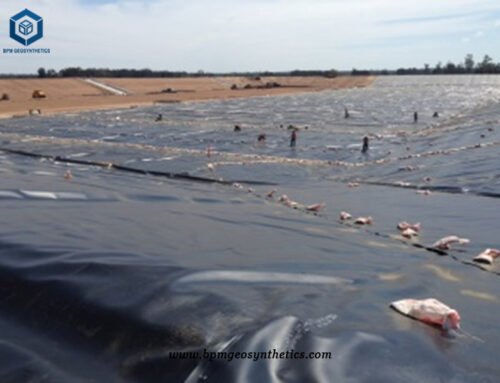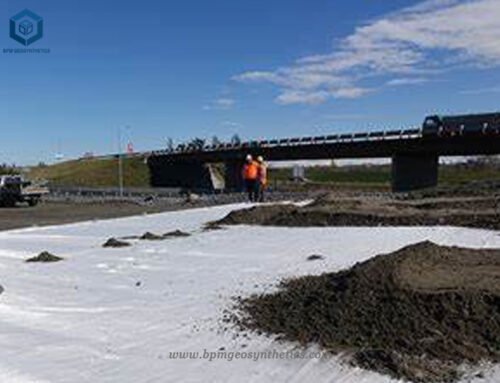Water tank liners, also referred to as tank liners, are cost-effective geomembrane liners used for old, new, or leaking liquid storage tanks. They can be applied to various tank materials, including steel, wood, plastic, underground, above ground, and concrete tanks. BPM Geosynthetics is a top manufacturer and supplier of geomembrane liners, offering custom manufacturing to match the shape, size, and configuration of your specific tank, pit, pond, or secondary containment. With BPM’s water tank liners, you can ensure an efficient and tailored solution for your liquid storage needs.
1. What Is Water Tank Liners?
Water tank liners is an impermeable membranes specifically designed to line the interior of water storage tanks, ponds, reservoirs, and other containment structures. Their primary purpose is to prevent leakage and contamination, ensuring the integrity and safety of the stored water.
These tank liners are manufactured using a variety of materials, including polyethylene, HDPE (high-density polyethylene), PVC (polyvinyl chloride), EPDM (ethylene propylene diene monomer), and other synthetic materials. Each material offers different properties and benefits, allowing for customization based on specific application requirements.
Water tank liners is essential for large outdoor or underground storage tanks where water is stored for various purposes such as agriculture, irrigation, firefighting, or potable water supply. By providing a reliable barrier against leaks, they help maintain the desired water levels and prevent loss or contamination.
The installation process for water tank liners involves carefully fitting and sealing the liner to the tank or containment structure. Proper installation ensures a tight and secure lining that effectively prevents any water seepage or escape.
In addition to preventing leakage, water tank liners also offer protection against external factors such as UV radiation, chemicals, and abrasion. This enhances the longevity and durability of the tank or containment structure, reducing the need for frequent repairs or replacements.
Water tank liners play a crucial role in maintaining the quality and safety of stored water. They provide an effective solution for preventing leaks, safeguarding against contamination, and ensuring long-term integrity and functionality of water storage systems.
2. How Much Does A Water Tank Liner Cost?
The cost of a water tank liner can vary depending on various factors such as the size of the tank, the material used for the liner, and the specific requirements of the project. It’s important to note that pricing can also vary depending on the region and the supplier.
To provide a rough estimate, let’s consider a specific example. Lining a round tank with dimensions of 8 meters in diameter and 3.6 meters in height (equivalent to approximately 10,000 gallons or 38,000 liters) for drinking water purposes may cost around $1200 (as of December 2024). However, it’s worth noting that this estimate excludes any additional expenses such as fixing extrusions or freight charges, which may be applicable depending on the specific project requirements.
It’s always recommended to contact suppliers or manufacturers directly to obtain accurate and up-to-date pricing information based on your specific project needs. They can provide you with detailed quotes based on the size, material, and specifications required for your water tank liner.
The key property of water tank liners that are exploited to control the permeation rate of a chemical species through the membrane. HDPE geomembrane tank lines have enough strength to be directly linked to the main frame unlike other roof materials. The geomembrane material has a natural tendency to curve, and although it can endure tension, it cannot withstand compression or bending.
3. Case Study
- Location – Malaysia
- Product – 1mm water tank liner
- Application – Shrimp Farm Tank


4. How Long Do Water Tank Liners Last?
The lifespan of water tank liners can vary depending on various factors such as the quality of the liner material, installation techniques, maintenance, and environmental conditions. Generally, water tank liners can last between 10 to 20 years before replacement may be necessary.
It’s important to note that this estimate is a general guideline, and the actual lifespan of a water tank liner can be influenced by several factors. Factors such as the type of liner material used (e.g., PVC, HDPE, EPDM), the quality of the liner, the water chemistry, exposure to UV radiation, temperature fluctuations, and mechanical stresses can impact the longevity of the liner.
Regular inspections and maintenance of the water tank liner are essential to maximize its lifespan. This includes monitoring for signs of wear, damage, or deterioration, and addressing any issues promptly. Proper cleaning and maintenance practices, such as regular removal of debris and sediment, can help prolong the lifespan of the liner.
It’s also worth noting that some manufacturers may provide specific warranty periods for their water tank liners, which can give an indication of expected durability. However, it’s important to follow the manufacturer’s guidelines for installation, usage, and maintenance to ensure optimal performance and longevity.
The lifespan of a water tank liner can vary, and it’s recommended to consult with the manufacturer or supplier of the specific liner you are considering to get more accurate information regarding its expected lifespan based on the specific circumstances and usage conditions.
5. Why Choose Geomembrane Tank Liners Malaysia for Shrimp Farm Project?
Aquaculture has experienced significant growth in Malaysia since its emergence in the 1920s and has become a crucial activity for improving local production, ensuring food security, and increasing export income. To address the challenges faced in the aquaculture industry, the use of preformed tank lining systems has gained importance.
Preformed tank lining systems are constructed using high-quality polyethylene virgin resin as the primary raw material. Additional additives such as carbon black, anti-aging agents, anti-ultraviolet absorbers, stabilizers, and other auxiliary materials are incorporated into the lining system. This combination of materials enhances the effectiveness of the system as a waterproof and barrier engineering material.
The use of preformed tank lining systems in aquaculture offers several advantages. Compared to traditional materials, these systems provide better cost-efficiency, longer service life, and increased economic benefits. The limitations of high costs, short service cycles, and low economic returns associated with traditional materials have hindered the rapid development of aquaculture. The adoption of preformed tank lining systems helps overcome these challenges and supports the sustainable growth of the industry.
By utilizing high-quality materials and advanced technologies in the construction of aquaculture tank linings, the preformed tank lining system offers improved durability, resistance to UV degradation, and enhanced performance in maintaining water quality and preventing leakage. This contributes to the overall success and viability of aquaculture operations by ensuring a controlled and optimal environment for the growth and cultivation of aquatic species.
6. Solution for Water Tank Liners for Shrimp Farm Project in Malaysia
The customer from Malaysia reached out to BPM after finding our website, inquiring about the quantity and price of HDPE water tank liners for their shrimp farm project. The specific tank dimensions provided by the customer were 30 meters in diameter and 2 meters in height.
Based on our expertise and understanding of the project’s requirements, we provided professional advice to the customer. After conducting local investigations and comparing multiple options, the customer agreed with our recommendation of using a 1.0 mm HDPE tank liner.
We proceeded to provide a quotation for the 1.0 mm HDPE tank liner and sent samples to the customer for evaluation. The customer expressed satisfaction with both the price and the quality of the product. As a result, they placed an order for the 1.0 mm HDPE tank liner due to its higher cost performance.
In addition to the tank liner, the customer also purchased a welding machine from us. This would enable them to properly install and join the tank liner, ensuring its effectiveness as a waterproof barrier.
By choosing BPM as their supplier and opting for the 1.0 mm HDPE tank liner, the customer found a suitable solution for their shrimp farm project in Malaysia. We were able to meet their requirements, provide competitive pricing, and deliver a quality product.


7. What Are Benefits of Water Tank Liners for Shrimp Farm Project in Malaysia?
(1)High intensity. The tensile strength of thick rubber pond liner can reach 18MPa, the tensile strength at break can reach 35MPa, the peel strength is 31kN/m, the shear strength is 33kN/m, and the ductility is good. The elongation at yield is 13% to 16%, and the elongation at break is 700% to 800%. It has good surface compliance and weather resistance. When it really fails, the strain is about 1000%.and especially for a round fish tank, the ground and sides need to bear the pressure alone. This physical characteristic makes fish farming safer and more durable.
(2)Good anti-seepage ability. The anti-seepage coefficient of thick rubber pond liner is less than 1×10-13cm/s, which can ensure that the leachate will not leak and contaminate the land due to the liner, rainwater will not pass through the covering layer of the closed site, increase the amount of leachate.The water storage capacity is good, the cost can be reduced in the process of fish farming, and the efficiency of fish farming can be improved.
(3)Good chemical stability. Thick rubber pond liner is the material with the best chemical stability among all HDPE Pond Liner Sheet materials. HDPE Pond Liner Sheet has good corrosion resistance.And it has no irritating smell, will not cause harm to the fish, and ensure the healthy growth of the fish.
(4)A fish tank can isolate pollution, and it can provide fish with a safe and hygienic growth environment. Compared with fish that grow in traditional fish ponds, fish tanks can reduce the damage of soil pollution to fish and reduce the chance of disease.
8. Specifications of Water Tank Liners for Shrimp Farm Project in Malaysia
- Total HDPE tank liner quantity – 40,600 squares meters
- HDPE tank liner thickness – 1.0 mm
- Each roll size is 5.8m*100m
9. About BPM Geosynthetics
BPM has been specializing in delivering one stop geosynthetics products and solutions to worldwide customers since its foundation in 2007. BPM had provided many types of effective and state of the art geomembranes, geotextiles, geocells, geosynthetic clay liners (GCLs), drainage boards, geogrids to over 81 countries. Our main customers are from Australia, France, Sweden, UK, Hong Kong, Hungary, New Zealand, Poland, Mexico, Ecuador, Brazil, Pakistan, Bangladesh, Thailand, Vietnam, Malaysia, Indonesia, Singapore, Philippines, Sri Lanka, India, UAE, Saudi Arabia, Qatar, Kenya, Ghana, Ethiopia, Somalia, Nigeria, South Africa, Swaziland, Mongolia, etc.





